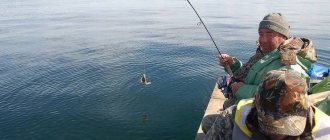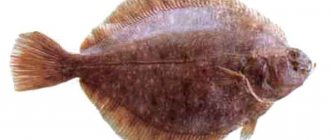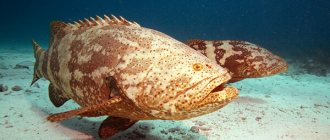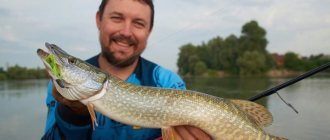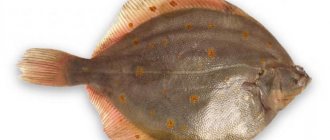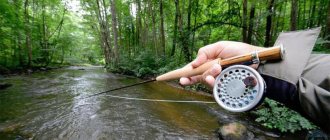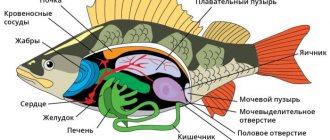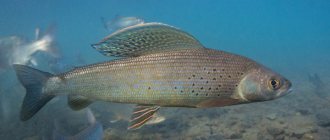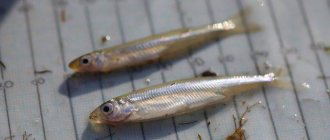Flounder
- a sea fish that belongs to the flounder family. The strongly flattened body, as well as the eyes located on one side of the fish, are its two most important differences. The eyes are most often on the right side. The body of the flounder is asymmetrical with a double color: the side with the eyes is dark brown with an orange-yellowish spot, and the “blind” side is white, rough with dark spots. Flounder feeds on crustaceans and bottom fish. In commercial catches, its average length reaches 35-40 cm. The fertility of adult flounder is from hundreds of thousands to ten million eggs.
Description
Flounder fish
All flounders have a flat body. The lower part is one of the sides of the fish that has moved as a result of undergoing metamorphosis, which is characteristic of all flatfishes. The lower part can be compared to sandpaper: it is very rough from constant contact with the bottom of the reservoir, there are no eyes here. The eye on this side moves to the other, since it is bad to observe what is happening with one eye.
The upper part of the fish contains the pectoral fins. There is also an eye that has moved from the bottom side. Flounder has a pigment that allows it to imitate any surface. This is necessary for the fish in order to hide at the bottom from predators who like to feast on it. If you put a flounder on a chessboard, then light and dark spots will certainly appear on the top, like on the board.
Varieties
There are two main types of flounder: river flounder and sea flounder. Externally, the fish are very similar to each other, but they may differ in size and body weight. There is a wide variety of flounder species within the genus, but the largest one is caught at sea. She weighed more than a hundredweight, and her body length was 2 meters. River flounder grows up to 50 centimeters and reaches a weight of 2 kilograms, and sea flounder grows up to 60 centimeters and weighs 7 kilograms. But in the photo they look about the same.
Of course, everyone who sees this type of fish for the first time is interested in the question: why is flounder flat? This is necessary in order to lead a benthic lifestyle and burrow into the soil as much as possible, imitating its structure, otherwise the fish will serve as food for predators. The young flounder swims vertically, and its appearance is normal, familiar to us. However, as the fish grows older, it undergoes a metamorphosis, and it already swims sideways, and all parts of the body are displaced for a more convenient existence.
Distribution and habitats
Marine and river flounder species have different habitats.
Marine fish live mainly in the waters of the Atlantic Ocean. But it is also common in the White, Northern and Okhotsk Seas. River flounder can live both in the sea and in rivers, where they can swim quite far. This fish lives in the Black and Mediterranean Seas, in the rivers flowing into them, as well as in the Yenisei. There is even a special type of flounder: Black Sea flounder. Varieties of flounder
Black Sea flounder is a valuable commercial fish that fishermen love to hunt. Black Sea flounder, like any other, prefers to lead a bottom-dwelling lifestyle. It is preferable for her that the soil be loose enough to burrow into it easily. But thanks to the ability of mimicry, this is not so important: how many colored stones there are on the bottom, the number of colors will be conveyed by the upper surface of the fish.
The benefits and harms of flounder
This fish has been well studied today. Dishes made from it are appreciated and loved in many countries around the world. It is used not only in cooking, but also in cosmetology. Due to the high content of beneficial amino acids and protein in this fish, it is used as raw material for the production of high-quality collagen. In addition, flounder meat leads among other types of fish in terms of selenium content, which improves skin condition, activates brain activity, strengthens bones and tooth enamel, and protects against harmful radicals. Star flounder has a beneficial effect on the body due to the content of Omega-3 polyunsaturated fats, amino acids and a minimal amount of fat, which leads to a decrease in cholesterol in the blood and has a beneficial effect on cardiac activity and vascular elasticity.
Habits
It doesn’t matter whether the flounder is freshwater or saltwater, all representatives of this family are very poor swimmers. Sensing danger, the fish turn over on their edge and quickly swim away in this position. As soon as the danger has passed, they sink back to the ground and burrow.
Depending on where the flounder lives, it is capable of changing its color at lightning speed, acquiring the desired shade. The color of the fish depends primarily on the color of the seabed and its pattern. When changing, flounder achieves such colors as to be practically invisible. This kind of adaptability is called mimicry. But not all representatives of this genus have this property, but only those that see. Having lost its sight, the fish will no longer be able to change the color of its body.
Flounder is a sea fish whose size ranges from a few grams to three hundred kilograms. Its weight and size depend primarily on the type. Some individuals reach four meters in length. Many of us have heard of halibut, but everyone knows that it is flounder. What kind of fish - river or sea - is certainly not known to many. Meanwhile, halibuts are the largest flounder that live in the Pacific and Atlantic oceans. A fish weighing 363 kilograms was recorded, and this is the largest value known to science. An interesting fact is that this species of flounder can live up to fifty years of age. In addition, flounder is a valuable marine commercial fish.
Flounder fish: description
Appearance
What is most interesting is that what is seen is not the truth. The back and belly of the flounder are actually the sides of the fish, some of which are colored and others not. At the same time, both eyes of the fish are located on one side, although they can look in different directions, independently of one another. This allows the fish to react in time to external stimuli, such as the enemies of flounder. They also help her hunt.
Adults lie on their sides, with their eyes moving to the top of the head, which is their characteristic feature. Determining how old an individual is is quite simple by the asymmetry of its body. In adult individuals, there is a strong asymmetry of the body, and the part of the body on which it spends almost its entire life is characterized by very pronounced roughness. Its color is somewhat pale, and its eyes are located on the other side. As for the other side, it is smooth and has a sandy color, which helps the fish camouflage on the bottom. The color of the top may depend on the fish's habitat. Young individuals are practically no different from ordinary fish species and swim just as vertically. In the process of growing up, certain metamorphoses occur. By the time of reproduction, the flounder becomes a flounder: the left eye moves to the right side, and the fish begins to swim horizontally.
Flounder hides from its enemies at the bottom, burying itself in sand or other soil. At the same time, she leaves her eyes outside to monitor what is happening around her. In this position, she also monitors potential prey. If it suits her, she instantly grabs it.
The lower part of the flounder has quite durable and rough skin. This is due to the fact that the fish mainly moves along the bottom, among scatterings of stones and shells, which can be quite sharp. To the touch, this part of the flounder’s body can be compared to sandpaper. There are species of flounder that can change color depending on their habitat, which helps the fish hide from their enemies.
Where does flounder live?
Flounder can be found in almost all oceans and seas. Most representatives of this species prefer the waters of the Pacific and Atlantic oceans, as well as the waters of the Sea of Japan, etc. Oddly enough, the flounder was discovered in the Mariana Trench, at a depth of 11 km. This type of flounder grows up to 30 cm in length. Three species of flounder live in the Black Sea. The largest species is the kalkan flounder. Some individuals are capable of gaining weight up to 15 kg. In addition, the kalkan flounder is capable of changing its color, adapting to external living conditions. This species of flounder has no scales.
In the Black Sea there are river flounder (gloss) and sole, which also belongs to this type of fish. Many fishermen note that the most catchy place is the Kerch Strait. In addition, fishing can be no less productive at Cape Tarkhankut, as well as at the mouths of the Dniester and Dnieper. The same types of flounder are also found in the Sea of Azov.
How does it reproduce
Flounder, compared to other fish species, is quite prolific. Adults are capable of laying up to ten million eggs. This fish lays eggs at a depth of at least 50 meters.
Flounder catch
Flounder meat is valued for its taste, which is why it is caught on an industrial scale. Especially, olive Japanese flounder and European flounder are in great demand. Flounders are also very popular among amateur fishermen, especially those that inhabit the northern and western parts of the Atlantic Ocean. As a rule, amateur fishermen go to the open ocean or open sea to catch this tasty fish and try their hand.
Diet
Flounder feeds very variedly. It can be classified as a predatory fish. The basis of nutrition consists of worms, mollusks and small crustaceans. But small fish that swim near the shelter are also often eaten. The fish does not like to leave it, so as not to become prey itself.
Despite the fact that flounder is a predator, fishermen prefer to use natural bait. To do this, they take worms or shellfish meat. For a fish to pay attention to its potential prey, it must be right under its nose. Otherwise, she is unlikely to come out of hiding, even to eat.
Origin of the species and description
The flounder family is a class of ray-finned fish belonging to the order Flounders. These fish are called right-sided flounders because... their eyes are located on the right side of the head. Some fish species are characterized by right-sided (reverse) eyes. The fins located on both sides of the flounder's belly are completely symmetrical and have a narrow base. The flounder family consists of 60 species of fish, grouped into 23 genera.
Despite the fact that each species has its own individual characteristics, there are still common features that are characteristic of all flounder, they have: a strongly flattened body; close-set eyes with a convex shape. Their movements can be multidirectional and completely independent of each other; unusual asymmetrical head; lateral line located between the eyes; a lopsided mouth and very sharp teeth; elongated fins equipped with many rays; the light blind side, which is covered by rough and dense skin; short caudal peduncle.
Flounder eggs do not have a fat drop, so they move freely in the water column (swim), sometimes developing in the upper layer. Only five species of the entire flounder family spawn bottom-dwelling eggs. It is worth noting that fish of different sexes have a number of differences among themselves. Males are more miniature than females, have a longer distance between the eyes, and their first rays of the dorsal and pectoral fins are also longer than those of females.
Reproduction
Flounder
Flounder breeds between February and May. This variation in timing is due to the fact that the habitat is quite wide, and in each case the fish has its own period of time when active spawning occurs. Despite the fact that flounder prefers to live alone, it gathers in schools for spawning. Sometimes several varieties of flounder mix in schools, and then crossing of different species can occur.
Flounder reaches sexual maturity at 3-4 years. During the spawning period, it spawns from several hundred to several million eggs. The amount of caviar depends on the type and size of the fish. The eggs survive an incubation period of 11 days, after which the fry hatch. The fry's left eye is on the left side, and the right eye is on the right: everything is like in ordinary fish.
After hatching, the fry feed on zooplankton, and as they grow, more nutritious food. Gradually the left side turns into the lower part, from which the eye moves to the right side. Very rarely the right side becomes the lower part. What this is connected with is still unknown to science.
Flounder is a very strange fish that has had to go through a long evolutionary path. Thanks to its features, it is almost invisible on the bottom, but experienced fishermen can force it to grab the hook by teasing the “bottom” with a tasty bait.
Star flounder: what kind of fish is it?
Flounder is found in many reservoirs of the planet. But star flounder can only be found in the northern waters of the Pacific Ocean.
The habitats of this species of flounder are the Seas of Japan, Okhotsk and Bering Seas. The territory of the river flounder population extends from the Korean coast to the waters of the Gulf of Anadyr.
It can be found less frequently in the Chukchi Sea. Star flounder is also called a Pacific river fish. In America, it is widespread up to southern California.
Star flounder (Platichthys stellatus).
The catch of star flounder in global production is not large. Its good bycatch of other flounder species can only be observed in the waters of the Western Kamchatka Peninsula and the Bering Sea, in the southeast of Sakhalin and in the oceanic part of Canada. The main distinguishing feature of the star flounder is the left-sided location of the eyes. In nature, there are practically no flounders of this species with eyes on the right side of the head.
Star flounder belongs to the genus of river flounder.
The body of this fish has no scales. The side of the body where the eyes are located is dark in color (brown or olive) and covered with spiked star-shaped plates.
The opposite part of the body is light in color. The fins of star flounder are painted in bright black stripes.
Star flounder got its name due to its color.
According to most scientists, star flounder prefers to settle in fresh waters near the coast. These can be river mouths, shallow bays, lagoons, etc. There were practically no cases of catching river flounder at great depths. The maximum catch always occurs in the coastal zone of the reservoir.
The average size of flounder living in Asian waters is 58 cm, with a body weight of more than 3 kg.
Star flounder is a freshwater fish.
In areas of the American coast, specimens measuring more than 90 cm and weighing from 9 kg are found. The average lifespan of a flounder is 18 years.
The name of this flounder means that it lives well in rivers and even moves along them over long distances (more than 150 km from the mouth). Spawning time for star flounder occurs in early summer. It can spawn even at sub-zero water temperatures. The diameter of each star flounder egg is 1 mm, and one female can lay from 500 to 2.5 thousand larvae at a time. An interesting fact is that flounder larvae, developed from eggs, initially have ordinary eyes, like other fish. But growing to a size of 15-20 mm, they settle to the bottom of the reservoir, after which a change in the position of the eyes of future star flounder fry occurs.
Like all flounder, star flounder is a bottom dweller.
Star flounder in the variety of its food has some differences depending on age. In the fry stage, it prefers to feed on various crustaceans, choosing river mouth zones as its habitat. And adults and large individuals (more than 30 cm in length) feed on small fish, shellfish and even fish waste.
Flounder is very tasty and healthy for the human body.
Due to the fact that the star flounder population is not very large, it is not customary to use it as the main catch in the fishery. Most often it acts as a bycatch of other flounder species. But fisheries experts believe that it is still possible to significantly increase the catch of star flounder in some areas of Kamchatka, the waters of the Sea of Okhotsk and the northeastern part of the Gulf of Sakhalin Island.
Live clams, shrimp, and pieces of fresh fish are good baits for star flounder. Flounder is caught on donkeys with a fishing line of 0.2-0.3 mm and hooks ranging in size from 7 to 10 numbers.
If you find an error, please select a piece of text and press Ctrl+Enter.
Fishing methods
Flounder is a bottom dweller, and therefore the hunting technique for it is appropriate. It is caught at a depth of 10 to 100 meters, with powerful carp and feeder rods using heavy equipment (from the shore), or by vertical lures from a boat, with the exception of non-sporting methods of fishing with nets. But it is better to choose special sea fishing rods that have a special coating against corrosive sea salt.
Small fish, crustaceans, various mollusks, squid, and worms (sea sandworm and nereis) are used as bait. Many fishermen prefer weighted artificial baits. You can attract her attention with beads of bright colors. It grabs the bait very sluggishly, so you may not notice the moment of the bite.
Harm and benefit to humans
Fishing for flounder
Nutritionists consider flat fish a medicinal product.
The composition of valuable substances makes flounder useful for diseases such as:
- hypothyroidism;
- cardiovascular diseases;
- chronic gastritis;
- cholecystitis;
- autoimmune diseases;
- chronic fatigue syndrome;
- anemia.
The benefits of flounder
In addition to dietary nutrition for chronic diseases, flounder is good in a regular diet.
Its beneficial properties provide:
- gaining useful weight during pregnancy;
- rapid recovery after serious illnesses;
- cancer prevention in older people;
- increasing mental performance and memory in schoolchildren and students;
- increased sexual desire;
- improving the structure of hair and nails;
- cleansing the skin, increasing its turgor.
Damage to flounder
Fish, as a rule, is not harmful to health. The health value of fish depends on the method of preparation. Flounder loses most of its beneficial properties when salted, smoked, or canned.
Flounder prepared in these ways can harm various organs of the human body:
- salted flounder retains fluid in the body, leading to edema and unhealthy weight gain;
- salted flounder puts excessive stress on the kidneys;
- salted and dried flounder concentrates salt in the joints, which leads to arthritis;
- smoked and canned fish are the source of carcinogens.
Important! Dried flounder without salt retains almost all valuable substances. But dried fish should not be eaten by people with gastrointestinal diseases.
